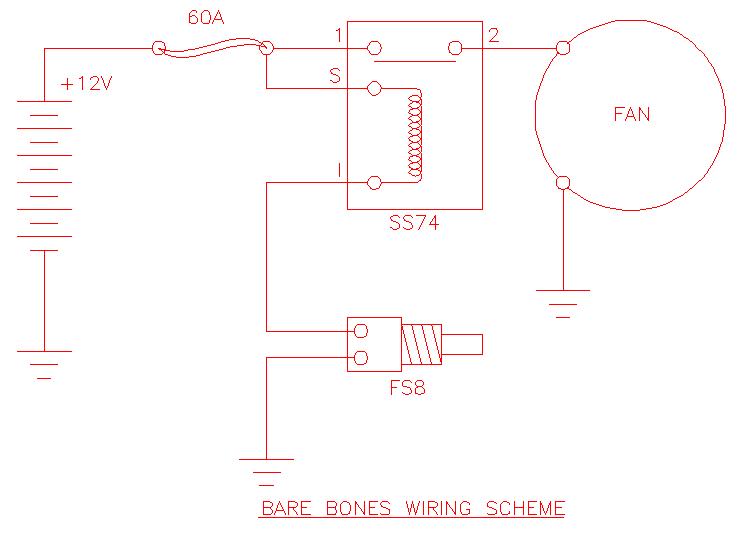Want to make an electric fan control harness without having to buy someone’s expensive solid state setup? See below for three ways you can go about it, depending on how many features you want.
- All of these setups are based on a Ford Taurus fan, or something with a fairly equivalent amp draw (approx. 38A continuous once it’s running).
- Relay SS74 marked in the diagrams is also equivalent to a NAPA ST85 or GP Sorensen SF74. You need a continuous-duty rated relay, with a capacity of at least 60A and referably closer to 80A for reliability. You also need the relay to have an isolated ground to work with these schematics. You can do this with a BWD SS664, which is easier to find, but the diagrams would need to be modified to suit the different relay design.
- FS8 is a temperature switch. Very important, you need a switch that is normally open, not a temperature sender. Here is where you’ll need to do some hunting, because you need to find something with the right thread for you to mount somewhere you can use, and with the temperature range you want. FS8 used to be an easy pick for Fords with an adjustable temperature, but I haven’t been able to find it lately.
- Other relays shown here can all be a standard Bosch style auto relay. I’ve been getting mine from All Electronics for years. No financial interest in them, I just find them to be a good supplier, and they seem to have the best price on these.
Scheme 1
As basic as it gets, here. This one will run any time the coolant is over the set temperature, including with the car turned off.

Scheme 2
This adds an AC Demand input to Scheme 1. This wire is usually easiest to find at the system pressure switch in your underhood A/C system. This wire will be powered all the time when your A/C is turned on from inside. For most cars, there are two wires here – make sure you tap into the wire that heads for the interior, not the one that runs from the pressure switch to the A/C compressor clutch. The compressor clutch wire will cycle on and off with A/C system pressure, the wire to the interior will not.

Scheme 3
This is the most versatile setup. Here, we add a switch (run to the interior) which will allow you to turn the fan on manually, off completely, or allow the same automatic operation as the first two schemes.

You can easily build off these schemes for more complex setups. A relay added off the I terminal of the SS74 will provide the ability to turn off the fan automatically when the ignition is off, for instance. One more relay, another sender, and a second SS74 will use both available speeds of the fan, though I’ve never personally seen much use for the low fan speed.
Please feel free to disseminate, modify, and enjoy!